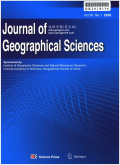- 钛学术文献服务平台 \
- 学术期刊 \
- 基础科学期刊 \
- 天文学、地球科学期刊 \
- 地理学报(英文版)期刊 \
How do GPM and TRMM precipitation products perform in alpine regions?A case study in northwestern China's Qilian Mountains
How do GPM and TRMM precipitation products perform in alpine regions?A case study in northwestern China's Qilian Mountains
基本信息来源于合作网站,原文需代理用户跳转至来源网站获取
摘要:
Satellite technologies provide valuable areal precipitation datasets in alpine moun-tains.However,coarse resolution still limits the use of satellite precipitation datasets in hy-drological and meteorological research.We evaluated different time scales and precipitation magnitudes of Tropical Rainfall Measurement Mission 3B43 V7(TRMM)and Global Precipi-tation Measurement(GPM)products for alpine regions using ground precipitation datasets from January 2015 to June 2019 obtained from 25 national meteorological stations and 11 sets of T-200B weighing precipitation gauges in the Qilian Mountains.The results indicated that GPM outperformed TRMM at all temporal scales at an elevation<3500 m with a higher probability of detection(POD),false alarm ratio(FAR),and frequency bias index(FBI)and performed best at 3000 m;TRMM performed better than GPM at an elevation>3500 m,with the best performance at 4000 m.GPM and TRMM had the best estimation accuracy in areas with monthly precipitation of 30 mm and 40 mm,respectively.Both TRMM and GPM products underestimated mid to large daily precipitation and overestimated light daily precipitation averaging<2 mm/d.This research not only emphasizes the superiority of GPM/TRMM in different regions but also indicates the limitations of precipitation algorithms.

推荐文章
GPM与TRMM降雨数据在黄河流域适用性分析
GPM
TRMM
降水
适用性分析
黄河流域
An experimental study on metal precipitation driven by fluid mixing: implications for genesis of car
Metal precipitation
Fluid mixing
Sulfur species
MVT lead–zinc ore deposits
Carbonate-hosted
lead–zinc deposits
GPM与TRMM降水数据在中国大陆的精度评估与对比
TRMM
GPM
降水量
流域分区
精度评价
分类统计指标
Ecological stoichiometry of nitrogen, phosphorous, and sulfur in China's forests
Forest
Stoichiometry
Nitrogen
Phosphorous
Sulfur
China
内容分析
关键词云
关键词热度
相关文献总数
(/次)
(/年)
引文网络
引文网络
二级参考文献 (0)
共引文献 (0)
参考文献 (0)
节点文献
引证文献 (0)
同被引文献 (0)
二级引证文献 (0)
2022(0)
- 参考文献(0)
- 二级参考文献(0)
- 引证文献(0)
- 二级引证文献(0)
引文网络交叉学科
相关学者/机构
期刊影响力
地理学报(英文版)
主办单位:
中国地理学会
中国科学院地理科学与资源研究所
出版周期:
月刊
ISSN:
1009-637X
CN:
11-4546/P
开本:
16开
出版地:
北京安外大屯路甲11号
邮发代号:
创刊时间:
1990
语种:
eng
出版文献量(篇)
1776
总下载数(次)
1
总被引数(次)
12509
期刊文献
相关文献
推荐文献
- 期刊分类
- 期刊(年)
- 期刊(期)
- 期刊推荐
力学
化学
地球物理学
地质学
基础科学综合
大学学报
天文学
天文学、地球科学
数学
气象学
海洋学
物理学
生物学
生物科学
自然地理学和测绘学
自然科学总论
自然科学理论与方法
资源科学
非线性科学与系统科学
地理学报(英文版)2022
地理学报(英文版)2021
地理学报(英文版)2020
地理学报(英文版)2019
地理学报(英文版)2018
地理学报(英文版)2017
地理学报(英文版)2016
地理学报(英文版)2015
地理学报(英文版)2014
地理学报(英文版)2013
地理学报(英文版)2012
地理学报(英文版)2011
地理学报(英文版)2010
地理学报(英文版)2009
地理学报(英文版)2008
地理学报(英文版)2007
地理学报(英文版)2006
地理学报(英文版)2005
地理学报(英文版)2004
地理学报(英文版)2003
地理学报(英文版)2002
地理学报(英文版)2001

 免费查重
免费查重










